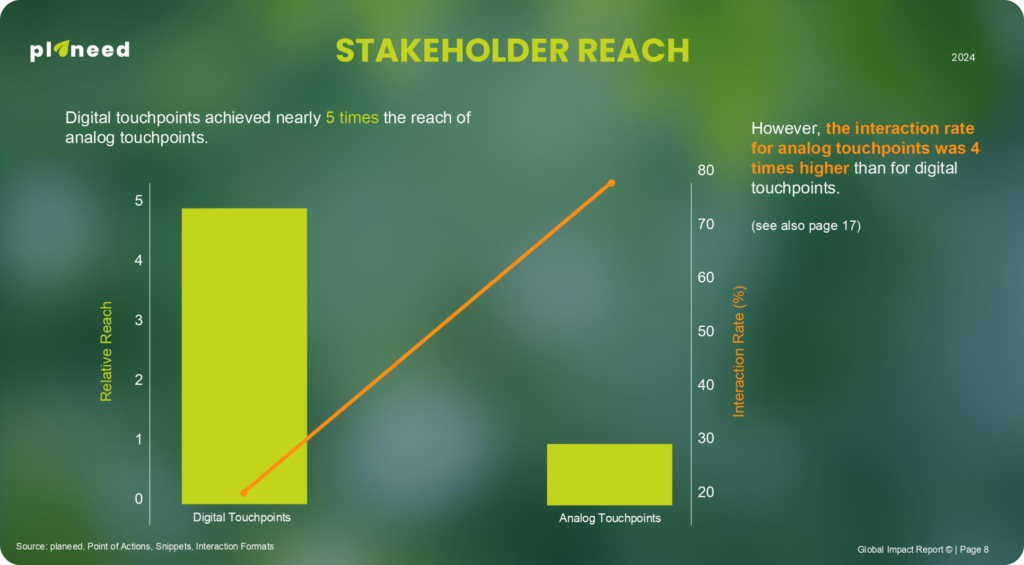Corporate Social Responsibility (CSR) has evolved beyond a mere compliance requirement; it is now a core component of business strategy, shaping brand reputation and stakeholder trust. However, the success of CSR initiatives does not solely depend on their execution but also on how well they are communicated. One of the key insights from planeed’s 2024 Global Impact Report is the importance of stakeholder reach in maximizing CSR impact.
The Role of Stakeholder Reach in CSR
Stakeholder reach determines how widely and effectively CSR initiatives are communicated across different platforms and audiences. According to the report, 24% of organizations created more than 20 Action Points, turning their CSR measures into dynamic, interactive conversations. More significantly, 60% of CSR measures leveraged additional digital and analog touchpoints, highlighting the increasing importance of cross-platform communication.
Digital vs. Analog Touchpoints: Striking the Right Balance
The report reveals a compelling contrast between digital and analog touchpoints. Digital channels achieved nearly five times the reach of analog touchpoints, yet analog interactions had four times higher engagement rates. This finding underscores the importance of a balanced approach—while digital channels offer extensive exposure, analog touchpoints drive deeper stakeholder connections and higher levels of interaction.

Stakeholders as Micro-Influencers
An exciting takeaway from the report is the role of stakeholders in amplifying CSR messages. Every second CSR measure was shared by stakeholders within their own communities, effectively turning them into micro-influencers. This organic reach reinforces the idea that successful CSR communication is not just about broadcasting messages but also about inspiring advocacy among stakeholders.
Maximizing Stakeholder Reach for Greater Impact
To enhance stakeholder reach and drive real impact, organizations should consider the following strategies:
- Integrate Multi-Channel Communication: Utilize a mix of digital and analog touchpoints to maximize both reach and engagement. Digital platforms provide scalability, while analog interactions foster deeper connections.
- Encourage Stakeholder Participation: Create CSR initiatives that invite stakeholder involvement, making it easier for them to share and advocate for the cause.
- Leverage Data-Driven Insights: Monitor engagement metrics to understand which touchpoints resonate most with stakeholders and refine communication strategies accordingly.
- Provide Shareable Content: Develop compelling narratives around CSR efforts that stakeholders are eager to spread within their networks.
Conclusion
Effective CSR communication is not just about making an impression—it’s about driving measurable impact. By optimizing stakeholder reach and leveraging both digital and analog touchpoints, organizations can enhance engagement, foster trust, and create a lasting difference. The insights from planeed’s 2024 Global Impact Report serve as a roadmap for organizations seeking to transform their CSR initiatives into powerful tools for business success and societal change.
Related Posts
Related Posts
Corporate Social Responsibility (CSR) has evolved from a peripheral concern to a central component of modern business strategy. Today’s stakeholders — customers, …
In an era of mounting ESG pressures and sustainability commitments, it’s easy for companies to get lost in the numbers. Tons of …
In today’s marketplace, businesses are more than just profit-generating entities; they are also pivotal players in the global community. Consumers, investors, and …



